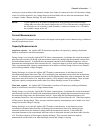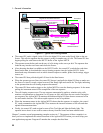
General Information - 1
17
sensing over local sensing is that when the remote sense leads are connected to the cell, the actual voltage
of the cell will be measured. Any voltage drops in the load leads will not affect the measurement. Refer
to chapter 2 under "Remote Sensing" for more information.
NOTE: If your Agilent MCCD system is configured for local sensing, the measured output
voltage may not reflect the actual voltage at the cell. This is because any voltage drops in
the wires due to wire resistance, probe resistance, connector resistance, etc. will reduce
the available voltage at the cell.
Current Measurements
The Agilent MCCD measures actual current in the output current path for each channel using a calibrated
internal measurement circuit.
Capacity Measurements
Amp-hour capacity - the Agilent MCCD determines amp-hour cell capacity by making calculations
based on continuous current measurements.
During charge, every time the Agilent MCCD makes a measurement, it calculates the actual incremental
amp-hours put into the cell during each measurement interval by multiplying the measured current times
the measurement interval. It then adds this incremental amount to the accumulated amp-hour value to
determine the total amp-hours delivered into the cell. Amp-hour capacity will be positive during charge.
Thus, accurate amp-hour capacity measurements can be made even when charge current is not constant,
such as during constant voltage charging.
During discharge, every time the Agilent MCCD makes a measurement, it calculates the actual
incremental amp-hours taken out of the cell by multiplying the measured current times the measurement
interval. It then adds this incremental amount to the accumulated amp-hour value to determine the total
amp-hours removed from the cell. Amp-hour capacity will be negative during discharge. Thus, accurate
amp-hour capacity measurements can be made even when discharge current is not constant.
Watt-hour capacity - the Agilent MCCD determines watt-hour cell capacity by making calculations
based on continuous current and voltage measurements.
During charge, every time the Agilent MCCD makes a measurement, it calculates the actual incremental
watt-hours put into the cell during each measurement interval by multiplying the measured current times
the measured voltage times the measurement interval. It then adds this incremental amount to the
accumulated watt-hour value to determine the total watt-hours delivered into the cell. Watt-hour capacity
will be positive during charge. Thus, accurate watt-hour capacity measurements can be made even when
charge current and voltage is varying.
During discharge, every time the Agilent MCCD makes a measurement, it calculates the actual
incremental watt-hours taken from the cell during each measurement interval by multiplying the
measured current times the measured voltage times the measurement interval. It then adds this
incremental amount to the accumulated watt-hour value to determine the total watt-hours taken from the
cell. Watt-hour capacity will be negative during discharge. Thus, accurate watt-hour capacity
measurements can be made even when discharge current and voltage is varying.


















